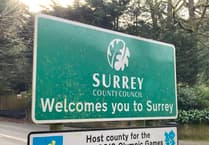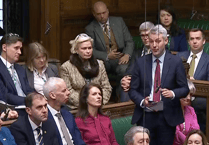CLIMATE activists are convinced that air pollution in parts of Woking is worse than is realised by the borough council.
The local branch of Extinction Rebellion – usually shortened to XR – is concerned that the council does not measure tiny polluting particulates in the atmosphere.
Nitrogen dioxide from vehicle exhausts is monitored, and excess amounts have been declared at two areas, but not the microscopic matter that is more dangerous to health, the group says.
Woking XR spokesman Andrew Malcher said the results from the independent network of particulate sensors set up by the local Green Party last year were alarming.
“The levels are very high near the M25 motorway,” said Mr Malcher, who is an engineer. “The World Health Organisation states that there is no safe level for particulates but advises that the average exposure to the smaller, PM2.5, particles should be below five micrograms per cubic metre on average and below 15 micrograms over a 24-hour period.
“We have recorded 50 micrograms and as much as 200 in Byfleet, just inside the M25, where there is an average or 40 to 50. The A320, A319 and A245 roads near the motorway are problem areas because of the large amounts of through traffic using them.
Mr Malcher said Public Health England records showed 40 people a year in Woking die prematurely from the effects of air pollution, which damages the development of the heart and lungs of growing children and causes cardiovascular disease in adults.
While nitrogen dioxide is a gas that comes mainly from vehicle exhausts, particulates in both solid and liquid form are generated by diesel engines, tyre and brake wear and also woodburning stoves.
“Woking Borough Council has acknowledged an air quality problem in Anchor Hill at Knaphill and Guildford Road near the town centre, where excess nitrogen dioxide has been recorded,” added Mr Malcher.
“They are planning to widen Guildford Road to try and avoid traffic jams, however the level of particulates, both PM2.5 and PM10 sizes, is more widespread and they are proven to be much more dangerous to public health, yet the council does not measure these toxins.”
A council spokesman said information regarding air quality is available on its website at wwwwoking.gov.uk/environmental-services/pollution/air-quality.
“The air quality in our borough is generally good,” says the website. “We carry out regular reviews to check current levels of pollutants and review predicted future levels against the government’s health-based standards.
“Every year, a report is produced on whether the air quality within the Woking area meets the national air quality standards. This is submitted to the Department for Agriculture, Food and Rural Affairs for their approval.”
Woking XR members gathered in the town centre to urge the council to record and publicise the level of particulates in the borough.
They want the authority to use its powers to reduce traffic coming through the town, divert spending from road building and support cheaper public transport and active travel opportunities.
Branch member Paula Tucker, a graphic designer, said: “The high level of air pollutants in the area is due to our over-dependence on fossil fuels for transport, energy and heating. This is also the cause of climate change and must be addressed urgently if we want to avoid the ecological disaster now rapidly approaching.”




